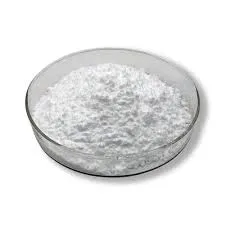
Aug . 07, 2024 18:20 Back to list
Exploring the Structural Characteristics and Applications of HPMC in Various Industries and Formulations
Understanding HPMC Structure A Key to Its Versatile Applications
Hydroxypropyl Methylcellulose (HPMC) is a widely used polymer derived from cellulose, which is obtained from natural sources like wood and cotton. The unique structure of HPMC is fundamental to its diverse applications across various industries, including pharmaceuticals, food, construction, and cosmetics. Understanding the structure of HPMC can help us appreciate its capabilities and the reasons behind its popularity.
HPMC is synthetically produced by modifying cellulose through the substitution of hydroxyl groups with hydroxypropyl and methyl groups. This modification enhances the solubility of cellulose in water and improves its functional properties. The molecular structure of HPMC exhibits a linear chain configuration where the backbone is formed by repeating anhydroglucose units, typical of cellulose, while the etherification process introduces hydrophobic hydroxypropyl and methyl side chains. The degree of substitution (DS), which indicates how many hydroxyl groups have been replaced, plays a crucial role in determining the characteristics of HPMC, affecting its solubility, viscosity, and gel-forming abilities.
Understanding HPMC Structure A Key to Its Versatile Applications
In the food industry, HPMC serves as a food additive used to improve texture, stability, and shelf life. Its ability to form gels and emulsions is instrumental in products such as sauces, dressings, and baked goods. Furthermore, it is utilized in gluten-free and low-fat formulations as a fat replacer, enabling manufacturers to meet the growing consumer demand for healthier alternatives without compromising on taste or texture.
hpmc structure

HPMC also finds its place in the construction industry, where it is added to cement-based products like plaster, tile adhesives, and mortars. It enhances workability and water retention, ensuring that the mixtures remain workable for extended periods without drying out too quickly. This property not only improves the application process but also contributes to the overall strength and durability of the finished structures.
In cosmetics and personal care products, HPMC acts as a thickening agent, stabilizer, and film-forming agent. Its film-forming capability is particularly beneficial in products such as shampoos, conditioners, and lotions, where it helps create a uniform application and improves the overall user experience.
Moreover, the environmental aspect of HPMC cannot be overlooked. Being derived from cellulose, HPMC is biodegradable and poses minimal environmental impact compared to synthetic polymers. This characteristic makes it a more sustainable choice for various applications, particularly as consumers become more environmentally conscious and seek products that align with their values.
In summary, the structure of Hydroxypropyl Methylcellulose (HPMC) is a key factor that underpins its versatility and widespread applications. The combination of hydrophilic and hydrophobic properties, along with its adjustable viscosity and biocompatibility, makes HPMC an invaluable ingredient in pharmaceuticals, food, construction, and cosmetics. As research continues and new applications are discovered, HPMC is likely to remain an essential component in these industries, driven by its unique structure and benefits.
-
Versatile Hpmc Uses in Different Industries
NewsJun.19,2025
-
Redispersible Powder's Role in Enhancing Durability of Construction Products
NewsJun.19,2025
-
Hydroxyethyl Cellulose Applications Driving Green Industrial Processes
NewsJun.19,2025
-
Exploring Different Redispersible Polymer Powder
NewsJun.19,2025
-
Choosing the Right Mortar Bonding Agent
NewsJun.19,2025
-
Applications and Significance of China Hpmc in Modern Industries
NewsJun.19,2025







